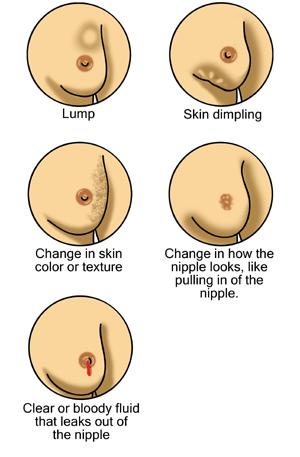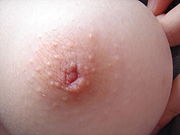
Breast disease
Encyclopedia
Breast diseases can be classified either with disorders of the integuement, or disorders of the reproductive system
. A majority of breast diseases are noncancerous.
Breast awareness is a goal of the breast health movement. Rather than promoting the largely ineffective, formally structured breast self-examination
s, breast awareness promotes informal familiarity with the normal state of a woman's breasts.
 A breast neoplasm is an abnormal mass of tissue in the breast
A breast neoplasm is an abnormal mass of tissue in the breast
as a result of neoplasia
. A breast neoplasm may be benign
, as in fibroadenoma
, or it may be malignant
, in which case it is termed breast cancer
. Either case commonly presents as a breast lump
. Approximately 7% of breast lumps are fibroadenomas and 10% are breast cancer, the rest being other benign conditions or no disease.
Phyllodes tumor
is a fibroepithelial tumor which can either benign, broderline or malignant.
(BSE) is an easy but unreliable method for finding possible breast cancer
. Factors that appear to be implicated in decreasing the risk of, early diagnosis of. or reccurence of breast cancer are regular breast examinations by health care professionals, regular mammograms, self examination of breasts, healthy diet, and exercise to decrease excess body fat.
Repeated occurrence unrelated to lactation requires endocrinological examination.
 Abnormal nipple
Abnormal nipple
conditions include:
Reproductive system
The reproductive system or genital system is a system of organs within an organism which work together for the purpose of reproduction. Many non-living substances such as fluids, hormones, and pheromones are also important accessories to the reproductive system. Unlike most organ systems, the sexes...
. A majority of breast diseases are noncancerous.
Breast awareness is a goal of the breast health movement. Rather than promoting the largely ineffective, formally structured breast self-examination
Breast self-examination
Breast self-examination is a screening method used in an attempt to detect early breast cancer. The method involves the woman herself looking at and feeling each breast for possible lumps, distortions or swelling....
s, breast awareness promotes informal familiarity with the normal state of a woman's breasts.
Neoplasms

Breast
The breast is the upper ventral region of the torso of a primate, in left and right sides, which in a female contains the mammary gland that secretes milk used to feed infants.Both men and women develop breasts from the same embryological tissues...
as a result of neoplasia
Neoplasia
Neoplasm is an abnormal mass of tissue as a result of neoplasia. Neoplasia is the abnormal proliferation of cells. The growth of neoplastic cells exceeds and is not coordinated with that of the normal tissues around it. The growth persists in the same excessive manner even after cessation of the...
. A breast neoplasm may be benign
Benign
A benign tumor is a tumor that lacks the ability to metastasize. Common examples of benign tumors include moles and uterine fibroids.The term "benign" implies a mild and nonprogressive disease. Indeed, many kinds of benign tumors are harmless to human health...
, as in fibroadenoma
Fibroadenoma
Fibroadenomas of the breast, are lumps composed of fibrous and glandular tissue. Because breast cancer can also appear as a lump, doctors may recommend a tissue sample to rule out cancer in older patients...
, or it may be malignant
Malignant
Malignancy is the tendency of a medical condition, especially tumors, to become progressively worse and to potentially result in death. Malignancy in cancers is characterized by anaplasia, invasiveness, and metastasis...
, in which case it is termed breast cancer
Breast cancer
Breast cancer is cancer originating from breast tissue, most commonly from the inner lining of milk ducts or the lobules that supply the ducts with milk. Cancers originating from ducts are known as ductal carcinomas; those originating from lobules are known as lobular carcinomas...
. Either case commonly presents as a breast lump
Breast lump
Breast lump is a localized swelling that feels different from the surrounding breast tissue. It is a symptom/sign for a variety of conditions. As approximately 10% of breast lumps ultimately lead to a diagnosis of breast cancer, it is important for women with a breast lump to receive appropriate...
. Approximately 7% of breast lumps are fibroadenomas and 10% are breast cancer, the rest being other benign conditions or no disease.
Phyllodes tumor
Phyllodes tumor
Phyllodes tumors , also cystosarcoma phyllodes, cystosarcoma phylloides and phylloides tumor, are typically large, fast growing masses that form from the periductal stromal cells of the breast...
is a fibroepithelial tumor which can either benign, broderline or malignant.
Malignant neoplasms (breast cancer)
Among women worldwide, breast cancer is the most common cause of cancer death. Breast self-examinationBreast self-examination
Breast self-examination is a screening method used in an attempt to detect early breast cancer. The method involves the woman herself looking at and feeling each breast for possible lumps, distortions or swelling....
(BSE) is an easy but unreliable method for finding possible breast cancer
Breast cancer
Breast cancer is cancer originating from breast tissue, most commonly from the inner lining of milk ducts or the lobules that supply the ducts with milk. Cancers originating from ducts are known as ductal carcinomas; those originating from lobules are known as lobular carcinomas...
. Factors that appear to be implicated in decreasing the risk of, early diagnosis of. or reccurence of breast cancer are regular breast examinations by health care professionals, regular mammograms, self examination of breasts, healthy diet, and exercise to decrease excess body fat.
Fibrocystic breast changes
Also called: fibrocystic breast disease, chronic cystic mastitis, diffuse cystic mastopathy, mammary dysplasiaInfections and inflammations
These may be caused among others by trauma, secretory stasis/milk engorgement, hormonal stimulation, infections or autoimmune reactions.Repeated occurrence unrelated to lactation requires endocrinological examination.
- bacterial mastitis
- mastitis from milk engorgement or secretory stasisStasis (medicine)In medicine, stasis is the state in which the normal flow of a body liquid stops, for example the flow of blood through vessels or of intestinal contents through the digestive tract....
- mastitis of mumpsMumpsMumps is a viral disease of the human species, caused by the mumps virus. Before the development of vaccination and the introduction of a vaccine, it was a common childhood disease worldwide...
- chronic subareolar abscessSubareolar abscessAlso called Zuska's disease , subareolar abscess is a frequently aseptic inflammation and has been associated with squamous metaplasia of lactiferous ducts....
- tuberculosisTuberculosisTuberculosis, MTB, or TB is a common, and in many cases lethal, infectious disease caused by various strains of mycobacteria, usually Mycobacterium tuberculosis. Tuberculosis usually attacks the lungs but can also affect other parts of the body...
of the breast - syphilisSyphilisSyphilis is a sexually transmitted infection caused by the spirochete bacterium Treponema pallidum subspecies pallidum. The primary route of transmission is through sexual contact; however, it may also be transmitted from mother to fetus during pregnancy or at birth, resulting in congenital syphilis...
of the breast - retromammary abscessAbscessAn abscess is a collection of pus that has accumulated in a cavity formed by the tissue in which the pus resides due to an infectious process or other foreign materials...
- actinomycosisActinomycosisActinomycosis is an infectious bacterial disease caused by Actinomyces species such as Actinomyces israelii or A. gerencseriae. It can also be caused by Propionibacterium propionicus, and the condition is likely to be polymicrobial aerobic anaerobic infection.Actinomycosis occurs rarely in humans...
of the breast - duct ectasia syndrome
- breast engorgementBreast engorgementBreast engorgement occurs in the mammary glands due to expansion and pressure exerted by the synthesis and storage of breast milk.It can be a cause of mastodynia....
Abnormal nipple conditions

Nipple
In its most general form, a nipple is a structure from which a fluid emanates. More specifically, it is the projection on the breasts or udder of a mammal by which breast milk is delivered to a mother's young. In this sense, it is often called a teat, especially when referring to non-humans, and...
conditions include:
- nipple dischargeNipple dischargeNipple discharge is the release of fluid from the nipples of the breasts. Although it is considered normal in a wide variety of circumstances it is the third major reason involving the breasts for which women seek medical attention, after breast lumps and breast pain. It is also known to occur in...
- inverted nippleInverted nippleAn inverted nipple is a condition where the nipple, instead of pointing outward, is retracted into the breast. In some cases, the nipple will be temporarily protruded if stimulated, but in others, the inversion remains regardless of stimulus...
s - supernumerary nipples
Other breast conditions
- supernumerary breastsAccessory breastAccessory breasts, also known as polymastia, supernumerary breasts, or mammae erraticae, is the condition of having an additional breast...
- gynecomastiaGynecomastiaGynecomastia or Gynaecomastia, , is the abnormal development of large mammary glands in males resulting in breast enlargement. The term comes from the Greek γυνή gyné meaning "woman" and μαστός mastós meaning "breast"...
(males) - Mondor’s diseaseMondor's diseaseMondor's disease is a rare condition which involves thrombophlebitis of the superficial veins of the breast and anterior chest wall...
- Paget's disease of the breastPaget's disease of the breastPaget's disease of the breast is a malignant condition that outwardly may have the appearance of eczema, with skin changes involving the nipple of the breast....
- nipple dischargeNipple dischargeNipple discharge is the release of fluid from the nipples of the breasts. Although it is considered normal in a wide variety of circumstances it is the third major reason involving the breasts for which women seek medical attention, after breast lumps and breast pain. It is also known to occur in...
, galactorrheaGalactorrheaGalactorrhea or galactorrhoea is the spontaneous flow of milk from the breast, unassociated with childbirth or nursing.Contemporary Maternal-Newborn Nursing Care defines galactorrhea as "nipple discharge." -Causes:... - breast cystBreast cystA breast cyst is a fluid-filled sac within the breast. One can have one or more breast cysts. They're often described as round or oval lumps with distinct edges. In texture, a breast cyst usually feels like a soft grape or a water-filled balloon, but sometimes a breast cyst feels firm.Breast cysts...
- mastalgiaMastalgiaMastodynia, mastalgia or mammalgia are names for a medical symptom that means breast pain .Pain can range from minor discomfort to severely incapacitating pain...
- galactocoele

